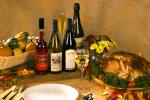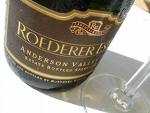[WRO Readers: We’ll be publishing Thanksgiving wine recommendations from our WRO contributors in this space almost every day until the holiday–so stay tuned! Michael Franz]
* * *
My consistent advice, “when in doubt drink Champagne or  Riesling,” is especially appropriate at Thanksgiving when the plethora of flavors on the table calls for the most versatile wines.
Riesling,” is especially appropriate at Thanksgiving when the plethora of flavors on the table calls for the most versatile wines.
And what better way to start the celebration–and that’s what Thanksgiving is–than to hear the “pop” of a Champagne cork. Since the guests around most Thanksgiving tables are as diverse as the food on them, it helps to have a wine that everyone enjoys. Champagne has universal appeal. I know people who avoid red wines and those who don’t like white wines, but I know very few who decline bubbly. Although most promotional materials show Champagne as an aperitif or as a celebratory toast, it’s a remarkably good accompaniment to food and can be consumed easily–and happily–throughout the meal.
Champagne ages and tastes best from a magnum, and Thanksgiving is the perfect time to bring out those big bottles. Try the non-vintage Charles Heidsieck Brut ($40 per 750 ml), in a full-bodied yeasty style, or non-vintage Pol Roger Brut ($33 per 750ml), which is slightly lighter, but no less enjoyable. For a real  splurge, try the Roederer 2002 Brut ($65 per 750 ml), which is moderately intense and extremely long and fine. If you insist, as my colleague Paul Lukcas does, that you must drink American wines on this holiday, head straight for Roederer Estate ($22), a wonderfully sophisticated sparkling wine.
splurge, try the Roederer 2002 Brut ($65 per 750 ml), which is moderately intense and extremely long and fine. If you insist, as my colleague Paul Lukcas does, that you must drink American wines on this holiday, head straight for Roederer Estate ($22), a wonderfully sophisticated sparkling wine.
Riesling is as versatile as Champagne, and another excellent choice for the Thanksgiving table. Its inherent acidity cuts through the food and refreshes the palate. I especially like  Trimbach’s 2006 Riesling ($18) or their superlative 2001 Riesling Cuvée Emile ($40). Slightly rounder, but still filled with engaging minerality and cutting acidity, is Grosset’s 2007 Polish Hill Riesling ($30) from Australia’s Clare Valley. For the American-only crowd (but delicious by any standard), pick up a few bottles of Dr. Konstantin Frank Vinifera Wine Cellars 2006 Dry Riesling ($18) from the Finger Lakes District of New York, which gets my vote for the best domestic Riesling.
Trimbach’s 2006 Riesling ($18) or their superlative 2001 Riesling Cuvée Emile ($40). Slightly rounder, but still filled with engaging minerality and cutting acidity, is Grosset’s 2007 Polish Hill Riesling ($30) from Australia’s Clare Valley. For the American-only crowd (but delicious by any standard), pick up a few bottles of Dr. Konstantin Frank Vinifera Wine Cellars 2006 Dry Riesling ($18) from the Finger Lakes District of New York, which gets my vote for the best domestic Riesling.
Although I think Chardonnay rarely works on Thanksgiving, there are those who feel it must be on the table to satisfy some guests. If that’s the case, look to Alex Gambel’s 2006 Bourgogne Blanc ($30), a stylish Chardonnay based wine that delivers a healthy dose of minerality with ripe fruitiness. Other satisfying choices include Shafer’s 2006 Red Shoulder Ranch Chardonnay ($46), Pine Ridge’s 2006 Dijon Clone Chardonnay ($33) or Girard’s 2006 Russian River Chardonnay ($24). A great bargain Chardonnay from Australia is Nine Stones’ 2006 ($15), which is considerably lighter and more refined than many from down under.
Red wines at Thanksgiving need to be light and devoid of drying tannins. If past experience is any judge, our usually thoughtful editor, Michael Franz, will lambaste me for suggesting Beaujolais (he’s wrong). I join Ed McCarthy, my colleague here at WRO,  and suggest avoiding Beaujolais Nouveau, which is often too grapey. But any of Jean-Paul Brun’s stunning array of 2007 Beaujolais–from a simple Beaujolais ($19) to his single cru Morgon ($21) and sold under the Terres Dorées label–are serious wines and delightful.
and suggest avoiding Beaujolais Nouveau, which is often too grapey. But any of Jean-Paul Brun’s stunning array of 2007 Beaujolais–from a simple Beaujolais ($19) to his single cru Morgon ($21) and sold under the Terres Dorées label–are serious wines and delightful.
Red Burgundy or West Coast Pinot Noir are great with turkey, but may not be the perfect match for cranberry sauce and the rest of the table. But good ones are so yummy, I wouldn’t argue if they wound up on my table. Try Jadot’s 2005 Santenay Clos de Malte ($25), or a super duper 2006 Longoria Pinot Noir from Sanford and Benedict Vineyard in the Santa Rita Hills of Santa Barbara County ($45).
More important than the wine is the company. Give thanks for good friends and everything else you have. Happy Thanksgiving.
2
